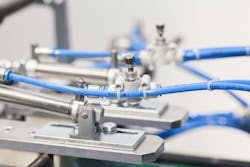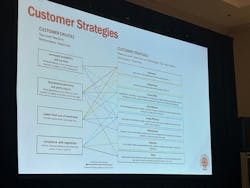It is no secret the fluid power industry is currently undergoing a technological evolution. Hydraulic and pneumatic systems are changing to meet an array of customer and industry requirements.
New system architectures are being evaluated, the number of integrated sensors is increasing and the inclusion of software is more common than ever. All of this is helping create systems which are more efficient, precise and capable of providing performance data.
Recognizing the many changes taking place in the industry, the National Fluid Power Association (NFPA) is assessing its own membership to be more inclusive of the various technologies and types of companies serving the fluid power market. On March 13, it announced the NFPA Board of Directors approved a new membership category — Controls, IoT and Data (CID).
This new membership category was created because of the increasing use of sensors within hydraulic and pneumatic systems as well as data capture and analytic functions. Much of this is helping to monitor performance and aid with maintenance, including the trend toward more preventative and predictive maintenance.
Per NFPA, companies in this new CID membership category are those whose involvement with the fluid power industry includes one or more of the following:
- Creation of data/inputs, such as manufacturers of sensors, human-machine interfaces, displays, joysticks or keypads;
- Systems that use data to control vehicles or factory floors, such as controller manufacturers;
- Solutions that send data to the cloud for further use, such as telematics or manufacturers of IoT (internet of things) hardware;
- Storing, processing and presenting data, such as cloud service providers; or
- Analyzing data to draw conclusions, such as data analytics firms.
Keith Simons of OEM Controls, one of the existing NFPA members that will transition to the new category, and NFPA Board Vice Chair, said, "The introduction of this new membership category underscores our commitment to adapt to the changing dynamics of the industry while fostering collaboration and innovation among a diverse group of stakeholders.
"By providing a dedicated platform for companies specializing in controls, IoT, and data, we aim to facilitate deeper engagement and address the evolving needs of our members in an increasingly interconnected world. We recognize the importance of staying at the forefront of industry trends and ensuring that we remain a dynamic and inclusive organization representing the fluid power community effectively."
READ MORE: The Continued Evolution of Hydraulics and Pneumatics
A Broader View of the Fluid Power Industry Emerges
NFPA began assessing the need to expand its member categories in 2023 as it laid out its strategic initiatives for the coming years and viewed adding new member categories as an important step to achieving those initiatives while also taking into account how broad the fluid power industry has become.
Electrified and connected machines are bringing an array of changes to fluid power systems such as the increased use of sensors. Other electrical and electronic components are becoming prevalent as well, making it necessary to take these component manufacturers and integrators into account because their interaction with those working on hydraulic and pneumatic systems is increasing. And fluid power professionals need to know more about their technologies as well.
While some NFPA members work in these areas, the association understands the need to bring more of them into their membership to help facilitate further growth of the fluid power sector. Hydraulic and pneumatic systems are not going away any time soon, but to continue being a relevant technology they need to evolve to meet the ever-changing requirements of the various markets served by fluid power.
During an NFPA quarterly technology conference on the topic of connected systems, DJ O’Konek, Engineering Manager at Nott Co., reviewed the various components now included in today's fluid power systems which includes CANbus, telematics and sensors in addition to hydraulic or pneumatic components.
This has made systems more complex as well as increased the need for design teams to understand what the various components do and their influence on the functionality of the overall system.
The 2023 NFPA Technology Roadmap, a document outlining potential development areas of focus for the industry, also demonstrates how much fluid power technology is evolving and what more is needed from it. Information within the roadmap is gathered from those working with hydraulics and pneumatics as well as customer markets. This ensures development efforts take industry needs into account.
The continued evolution of the fluid power industry is also a key reason for Power & Motion's rebranding in 2022. Fluid power is still a very important technology, but includes so much more today than just hydraulic and pneumatic components. Our goal is to keep the industry informed of the technology and trends influencing current as well as future fluid power system designs to help ensure the longevity of the industry.





